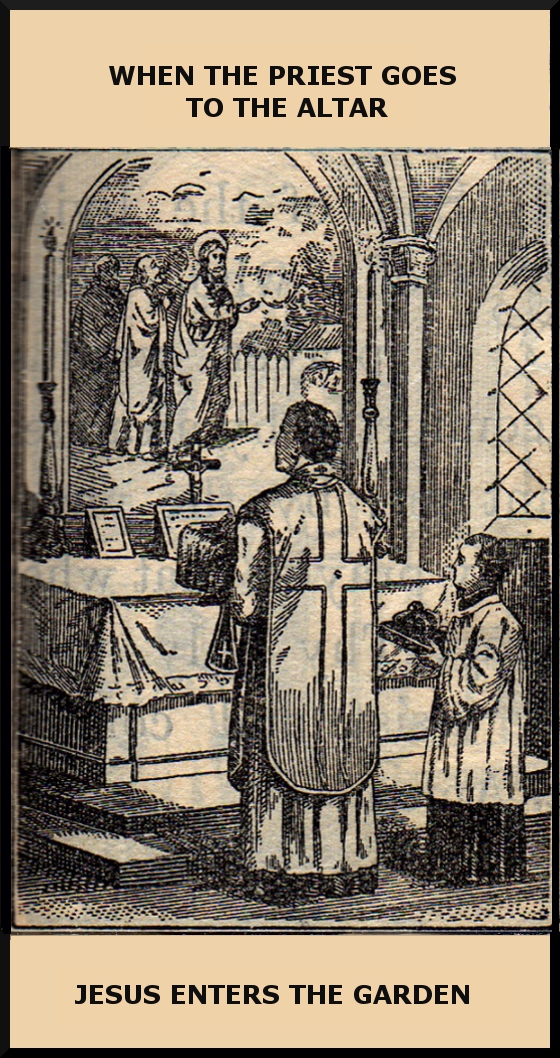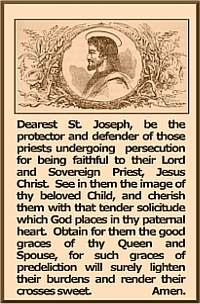I am going to begin a series using graphics taken from an old book, which hopefully will help people understand what the Mass is. If one’s experience is only with the Novus Ordo, more than likely, the illustrations will make little sense. You will not see laity traipsing all over the sanctuary, the profanation of Communion in the hand, smiley Eucharistic ‘ministers’, etc.
Keep in mind that as the church worships, so she believes, and vice-versa, and that one’s beliefs carry-over into one’s comportment and dress when worshiping God. I know that many who have made the transition over to the TLM have marveled at the differences; that it was like a sigh of relief in having left behind what in comparison was a form of worship with Protestant-like flavor, something which smacks of a Lutheran service; a place where most people dress so casually, that one would think the whole affair was nothing more than an informal social event.
Since this will be a time-consuming labor, I will probably write very little to accompany the illustration. As they say, a picture is worth a thousand words. Here is the first one:
 St. Alphonsus Liguori tells us that in order to sacrifice a victim, one must have power over its life; since God is the only one to have such power over his Divine Son who is the Victim in the unbloody Sacrifice of the Mass, it is a duly ordained priest invested with divine authority who approaches the altar of sacrifice. By praying in union with Jesus – principal priest – in the name of the Father, and of the Son, and of the Holy Ghost, he thus begins the Mass declaring that he offers the Sacrifice with the authority of the Holy Trinity.
St. Alphonsus Liguori tells us that in order to sacrifice a victim, one must have power over its life; since God is the only one to have such power over his Divine Son who is the Victim in the unbloody Sacrifice of the Mass, it is a duly ordained priest invested with divine authority who approaches the altar of sacrifice. By praying in union with Jesus – principal priest – in the name of the Father, and of the Son, and of the Holy Ghost, he thus begins the Mass declaring that he offers the Sacrifice with the authority of the Holy Trinity.
As the priest approaches the foot of the altar, we recall at this moment, Jesus entering the Garden of Gethsemane, where, leaving His companions at a little distance, He begins to pray.
We should unite ourselves with the priest and pray: “Lord Jesus Christ, Son of the living God, who when Thy Passion drew near, wouldst for me wretched sinner, fear and grow sad; grant that I may ever direct all my sorrows unto Thee, the God of my heart; and Thou, O Lord, in union of Thy passion and sorrow, deign to assist me to bear them with patience, that by the merits of Thy sufferings they may be salvific to me. Amen.”




You are more than welcome, Catherine. I am going to be putting them up on FB, also.
It has been good making a connection with you and the other trad “hardheads”. 🙂
In their Hearts,
Fiat (aka Maty)
+J.M.J
Thank you, Maty, for your wonderful work, truly a labor of love. I would like to share one each day on my FB, to hopefully help my loved ones who do not have an understanding of the True Mass.
God bless you,
Catherine
Thank you. I am happy to know that they are of benefit to those wanting to love our Lord more in the sacrifice of the Mass.
Believe it or not, the drawings are from a little child’s book printed in 1925, and having the imprimatur of Patrick Cardinal Hayes. I’ve had to do editing, enhancing, framing,etc, but the prayers found therein are pretty much an exact reproduction. Can you believe it, that children were taught to pray like that back then?
God bless you, Steve.
Maty
Where are these images from? They are beautiful! And so instructive!